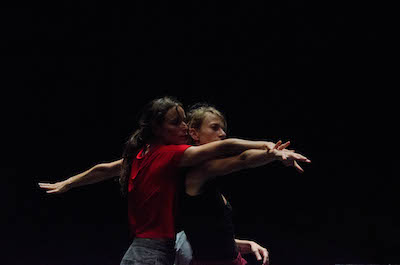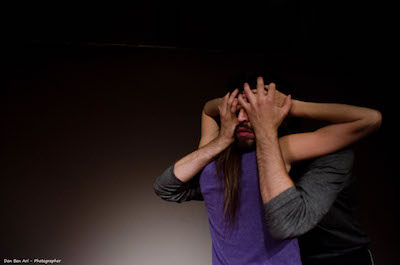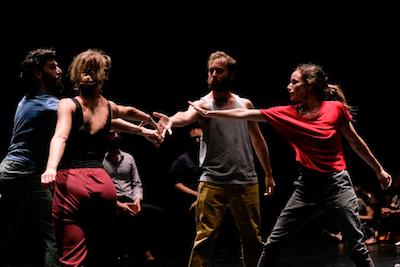The Physical Intimacy of Siblings by Ori Lenkinski

*originally published in Hebrew in Haaretz
Not long ago, the mother and father of a close friend of my daughter’s came to see a performance I was dancing in. The next morning, after sharing her impressions of the performance, the woman told me that her husband couldn’t believe my husband didn’t mind my participating in such a show.
“How does he let her do that?” he had asked her.
That evening, I told my husband about the conversation. The thought that he would be threatened by my participation in this show was preposterous to us both, however, we could understand the reasoning.

Photo by Dan Ben Ari
The performance, Q and A by Rachel Erdos, is about intimacy and closeness. During the show, my fellow cast members and I come into physical contact with one another. We hug, we look into one another’s eyes, we lift each other… the other female dancer and I have a duet that involves many kisses on the forehead. We ask each other and the audience personal questions about childhood, fear, family and death. There is touch, not sexual or romantic in nature but touch, nonetheless. And there is intimacy.
I have been asked about the connection between dancers many times in the past. People notice that dancers are touchy with one another, that they hug for longer stretches than most and are likely to add a shoulder squeeze to a greeting. This is often misinterpreted by outside eyes as something romantic while it is actually close to the opposite. Dancers who work together usually end up feeling like siblings.
Because contact is an integral part of many dance pieces, getting to know one another’s bodies is a must. Familiarity with a fellow dancer’s body is not just an outcome of a creative process, it is an elemental part of ensuring physical safety. Dancers who work together know about one another’s past injuries, they know what is sore and where not to put weight, they know about one another’s centers of gravity and tendencies. These bits of information allow dancers to fully trust one another with their body. This trust allows for the type of virtuosic movement that makes dance so engaging.

Photo by Dan Ben Ari
Dancers approach the body as material and, as such, are able to remove any kind of sexual energy that touch would normally elicit. There is something deeply freeing about this connection, similar to that of siblings.
Our siblings’ bodies are the ones that we will know best outside of our own. We see them grow, we approach one another without ceremony or inhibition, we sleep and eat and breath and develop one alongside the other. We have a connection that will never be recreated or replaced by another human.
On stage, our fellow dancers have our backs like siblings do throughout life. Even in the most rehearsed and performed show, surprises happen. There is always an element of surprise on stage, always a possibility for mishaps. When we enter into a contract to perform together, dancers take responsibility for one another. Whatever happens, they must support one another.

When I look at my two children huddled together over a book, squished together under a blanket or climbing one over the other to reach a toy, I think of that physical intimacy. I remember the same kind of informal yet deeply familiar contact throughout my childhood with my sister.
The little one places her hand on the big one’s leg without even noticing she’s doing it. The touch is so natural to them both, it goes completely unnoted. That physical connection is one of the most comforting and delightful parts of childhood and, as such, of life.
